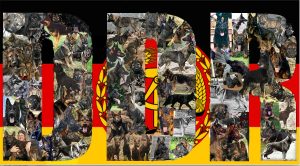Old DDR German Shepherd Dogs

From the time the walls went up in 1961, until it came down in 1989 when Germany was “reunified”, the breeders of German Shepherds were limited in their choices of breeding stock. A separate breed registry had to be instituted in the DDR, and the SDG Service and working dogs came to be. In the (DDR) the physical, drive, and mental characteristics and traits of Schutzhund and working dogs were rated by the Wertmessziffer system. In English Wertmessziffer means “measured value number.” Breeders and buyers depended on this 6-digit rating system to provide a comprehensive and reliable method for easily determining the characteristics of each evaluated and rated dog. More on this system can be found here. DDR Wertmessziffer Rating System
For example, a dog with a 6545/55 rating would be powerfully built with ideal constitution and.

and good angulations. It would be an even tempered, good natured dog, yet very hard against influence. As reflected in the last two digits after the slash, hardness and sharpness would be very good. It refers to a dog’s inherent stimulation threshold and desire to pursue and attack. It does not imply “nervy”, fearful, flighty responses.

You may have come across the expressions “no line 13”, or Line 5-A, etc. In the old DDR, certain much-used foundation dogs’ bloodlines (Zucthlinien) were given a corresponding number, sometimes seen on a pedigree as ZL:XIII-A (13-A) or ZL:XII (12) etc,
When another dog in future generations became a very proponent sire, he was given his own corresponding number, and so on. Their offspring carried the sire line’s number (never the dam’s). By learning a little about the bloodlines, and by knowing who the key sires were, you can glean a great deal of information about the dogs in their background, just by knowing the ZL#. More on Zucthlinien Here. Today’s “DDR dogs” originate from these lines.
DDR German Shepherd Lines:: 5A: This line descends from Alf v. Nordfelsen and is predominantly propagated by Don v. Rolandsteich and his descendants. 11A: This line originates from Rolf v. Osnabruecker Land and is continued predominantly through Bernd v. Lierberg and his descendants like Pushkass v. Haus Himpel and Olf v. Fuerstendamm. 11B: This line descends from Ex v. Riedstern primarily through Cliff v. Bleichfleck. 11C: This line originates from V Ali vom Gränert,V Barry vom Andershofer Ufe,V Drusus vom Falkenwappen,V Geier vom Baruther Land,Bodo v Winkel, Casar v Rangental, Lars v Furstendamm, Seigo v Angerholz…Grand vd Ziegelwiese, Boy v Hohenwarthereck, Henk vd Moschelwith.
11D: This line radiates from Ingo v. Rudingen leading to Held v. Ritterberg and Jeff v. Flaemings Sand through his sons Flint v. Steiglerhof, Birko v.d. Wolfshoehle, and most famous of all Lord v. Gleisdreieck. 11E: This line comes through 2x DDR seiger Condor v. Maderpfahl and radiates through Ohle v. Rundeck into the studs Fels v. Kemmlerblick and Zorro v. Laagerwall. 12: This line today descends primarily from Golf v. Ritterberg and his brother Grand v. Ritterberg. 13A: This line today persists primarily through the descendants Alf v. Koernersee.

Preserving the DDR lines implies standing still, not improving the line. We need to preserve the image of the breed as it was and build on top just as they would have done. The most important thing we can do is to retain the DDR body style & type while maintaining and improving as strong as genetic diversity as we possibly can for the health of the bred.
The standards we look for include powerful, deep chested bodies with almost straight square frames, intimidating presence and supreme intelligence. Working abilities include tracking, athleticism, toughness, climbing abilities, hardiness, and the ability to withstand extreme physical conditions and demands. These are the strict guidelines imposed on the breed, and resulted in the creation of the DDR Shepherd one the finest working animals the world has ever had, with thanks to a few. Please note that most of the best dogs for breeding and security in the DDR did not go to the Military they went to friends and families of the breeders.  They can make, with proper guidance some of the best family pets you will ever have. These lines are amazing, and as each member of your family is different from the next, puppies are no different.
They can make, with proper guidance some of the best family pets you will ever have. These lines are amazing, and as each member of your family is different from the next, puppies are no different.
One sister/brother may excel in martial arts, police or military while one is best suited as a care giver, a nurse or doctor. Some of our puppy’s are best suited for family life, some as protection dogs and some for Police and Military. Once your needs are identified we will help you choose the right new family member or partner.

1 thought on “Understanding DDR Lines”